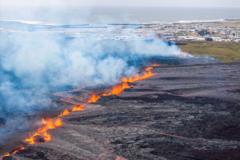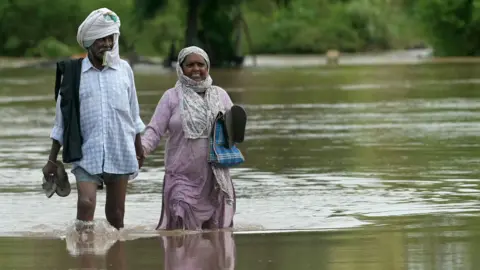Authorities in South-West Iceland issued urgent evacuation orders following the explosive eruption of a local volcano, which has been spewing lava and sending tremors through the region. The eruption began in the morning, creating a 1.2-kilometer crack in the earth and raising alarm among residents and tourists alike, especially in Grindavik, a fishing town near the famous Blue Lagoon spa.
Despite evacuation orders, a small number of residents opted to remain in their homes, with reports indicating that some expressed a strong desire to stay despite the dangers. Local resident Asrun Kristinsdottir recounted her experience of fleeing from the emergency sirens, noting the enduring fear brought on by "constant" tremors preceding the eruption.
The Icelandic Meteorological Office (IMO) reported that protective barriers surrounding Grindavik had been breached with a new fissure opening dangerously close to the town, raising additional concerns about potential lava flows encroaching on inhabited areas. Rikke Pedersen from the Nordic Volcanological Centre confirmed there was now a serious threat to Grindavik from the volcanic activity, leading civil authorities to direct residents to leave the perilous zone.
The town's hot water pipes have also been reported broken due to significant cracks in the region, illustrating the immediate impacts of volcanic activity. However, people began to see some reprieve from the eruption as volcanic activity lessened later in the afternoon.
Residents, including Thormar Omarrson, who ran a pizza restaurant, reflected on their emotional decision to evacuate. After warnings about the increasing volcanic risk, he and his family left Grindavik last year, describing it as "heartbreaking" to abandon the community where they had lived for three decades.
The eruption marked yet another phase of increased volcanic activity in Iceland, which has seen repeated eruptions in the Reykjanes Peninsula since 2021. With the ongoing changes in magma flow under the region, the risks of a prolonged eruptive phase remain. The volcanic activity poses potential air pollution threats as winds carry gas emissions toward the capital area, urging continued vigilance among local residents and authorities.
The last significant volcanic period for Iceland’s Reykjanes Peninsula occurred around 800 years ago, emphasizing the urgency and magnitude of current events. With approximately 33 active volcano systems, Iceland is no stranger to geological activity, underscoring the critical need for preparedness amid an increasingly dynamic environment.


















